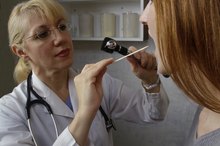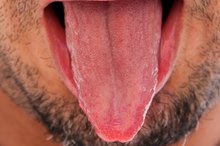The Effects of Smoking on the Tongue
Smoking harms nearly every organ of the body and can affect your overall health. Not surprisingly, it can also affect your tongue. Smoking can irritate your tongue and increase your chances of developing a number of oral conditions, ranging from changes in the sensitivity of your taste buds to the development of tongue cancer. Regular dental checkups may help prevent tongue disorders or at least allow them to be detected early so that appropriate treatment can be started.
Changes in Taste
Smoking may affect the taste buds on your tongue, leading to a decreased ability to taste normally. Using a very sensitive testing device that stimulates taste buds with an electrical current, a study published in August 2009 in "BMC Ear, Nose and Throat Disorders" found that 80 percent of smokers had a lower ability to detect taste compared to nonsmokers 1. The researchers suggested that this was due to changes in the shape and number of papillae -- small bumps on the surface of the tongue where the taste buds reside.
However, smoking may not alter all types of taste sensation. According to a study published in the March 2014 issue of "Chemosensory Perception,” only bitter taste was affected 2. In that study, smokers and nonsmokers detected salty, sweet and sour tastes equally well, but smokers were less likely to be able to detect a bitter taste.
- Smoking may affect the taste buds on your tongue, leading to a decreased ability to taste normally.
- Using a very sensitive testing device that stimulates taste buds with an electrical current, a study published in August 2009 in "BMC Ear, Nose and Throat Disorders" found that 80 percent of smokers had a lower ability to detect taste compared to nonsmokers 1.
Black Hairy or Coated Tongue
Diseases and Disorders of the Tongue
Learn More
The surface of the tongue is protected by a thin layer of dead cells composed largely of keratin. This layer is normally shed at the same rate that it is produced. Chronic irritation, as occurs with smoking, can upset this balance, causing keratin to accumulate, particularly along the midline of the tongue. When the accumulation is not severe, the condition is called a coated tongue. A black hairy tongue occurs when the accumulation becomes severe, creating the appearance of hair 4. Tobacco pigment, food or mouth bacteria collect between the hair-like structures, causing a black or brown discoloration. Black hairy tongue is not harmful but it can be unsightly and contribute to bad breath.
- The surface of the tongue is protected by a thin layer of dead cells composed largely of keratin.
- Tobacco pigment, food or mouth bacteria collect between the hair-like structures, causing a black or brown discoloration.
White or Red Patches
Leukoplakia and erythroplakia are patches that can develop anywhere in the mouth, including the tongue. They are more common in tobacco smokers than nonsmokers. Leukoplakia usually appears as a white patch that can't be rubbed off, whereas erythroplakia appears as a flat or depressed bright red area that may bleed easily if scraped. Neither condition tends to cause symptoms, although mild discomfort is sometimes noted.
Both may be precancerous, though erythroplakia is more likely to become malignant. Indeed, a September 2011 review article in "Australian Dental Journal" estimated that 45% of erythroplakia patches may eventually develop into a cancer 6. If leukoplakia or erythroplakia appears, a biopsy will often be performed by removing the patch and sending it to a laboratory to look for the presence of cancer cells.
- Leukoplakia and erythroplakia are patches that can develop anywhere in the mouth, including the tongue.
- Leukoplakia usually appears as a white patch that can't be rubbed off, whereas erythroplakia appears as a flat or depressed bright red area that may bleed easily if scraped.
Cancer
Negative Effects of Black & Mild Cigars
Learn More
Tobacco smoke contains known cancer-causing molecules that may contribute to the development of squamous cell carcinoma of the tongue -- the most common type of oral cancer. People who both drink an excessive amount of alcohol and smoke have a particularly increased risk of developing tongue cancer. This cancer typically appears as a firm ulcer -- like a crater -- with raised borders that does not heal, and it is usually located on the sides or underside of the tongue. It can spread to the soft tissue in the floor of the mouth and interfere with tongue mobility and speech.
- Tobacco smoke contains known cancer-causing molecules that may contribute to the development of squamous cell carcinoma of the tongue -- the most common type of oral cancer.
- This cancer typically appears as a firm ulcer -- like a crater -- with raised borders that does not heal, and it is usually located on the sides or underside of the tongue.
When to Seek Medical Attention
Sometimes a sore on your tongue can be annoying or painful without being harmful, but other times a tongue problem can indicate a more serious condition. See your doctor or dentist if you experience any of the following symptoms for longer than about 2 weeks: a red or white patch, difficulty moving your tongue, or any thickened area, lump, rough spot or ulcerated area.
Related Articles
References
- BMC Ear, Nose and Throat Disorders: Evaluation of Young Smokers and Non-smokers With Electrogustometry and Contact Endoscopy
- Chemosensory Perception: Differential Perception of Caffeine Bitter Taste Depending on Smoking Status
- American Journal of Medicine: Black Hairy Tongue
- Oral Leukoplakia Manifests Differently in Smokers and Non-smokers
- Journal of the Canadian Dental Association: Tobacco-Associated Lesions of the Oral Cavity: Part II. Malignant Lesions
- American Dental Association: Oral Cancer
- Journal of the Canadian Dental Association: Tobacco-Associated Lesions of the Oral Cavity: Part I. Nonmalignant Lesions
- Kim AM, Keenan BT, Jackson N, et al. Tongue fat and its relationship to obstructive sleep apnea. Sleep. 2014;37(10):1639–1648. Published 2014 Oct 1. doi:10.5665/sleep.4072
- Bartlett JA, van der Voort Maarschalk K. Understanding the oral mucosal absorption and resulting clinical pharmacokinetics of asenapine. AAPS PharmSciTech. 2012;13(4):1110–1115. doi:10.1208/s12249-012-9839-7
- National Organization for Rare Diseases. Tongue Cancer.
- Dotiwala AK, Samra NS. Anatomy, head and neck, tongue. [Updated 2019 Feb 8]. In: StatPearls. Treasure Island (FL): StatPearls Publishing; 2019 Jan.
- Moore KL and AF Dalley. Clinically Oriented Anatomy. Lippincott Williams & Wilkins, 4th edition, 1999, pp. 940-947.
- Stone M, et al. Structure and variability in human tongue muscle anatomy. Comput Methods Biomech Biomed Eng Imaging Vis. 2018;6(5):499–507. Published online 2016 Apr 8. doi:10.1080/21681163.2016.1162752
Resources
Writer Bio
Keren Price began medical writing in 1997. Over the years, she has written for a wide range of clients, including Medtronic, Salix Pharmaceuticals, and General Mills. Prior to her medical writing career, Price was the managing editor of the Journal of Nutrition Education. She earned a Bachelor of Science in biopsychology from Tufts University and a Master's degree in nutrition from Penn State.









